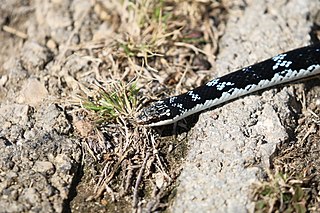
Mastigodryas boddaerti, commonly known as Boddaert's tropical racer, is a species of snake in the family Colubridae. The species is native to tropical South America including Trinidad and Tobago.

Oxyrhopus petolarius, commonly known as the forest flame snake, is a species of mildly venomous snake in the family Colubridae. The species is endemic to Central and South America. There are three recognized subspecies.

Xenodontinae is a subfamily of snakes in the family Colubridae.
Hoogmoed's tree frog is a species of frog in the family Hylidae found in Guyana, possibly Brazil, and possibly Venezuela. Its natural habitats are subtropical or tropical moist montane forests and rivers.

Oxyrhopus, the false coral snakes, is a genus of colubrid snakes that belong to the subfamily Dipsadinae. All 15 members of the genus are found in the northern part of South America, with the native range of the most widespread member, Oxyrhopus petolarius, extending into Central America and Trinidad and Tobago as well.
Atractus albuquerquei, commonly known as the Albuquerque ground snake, is a species of small burrowing snake in the family Colubridae. The species is endemic to South America.
Osvaldo Rodrigues da Cunha was a Brazilian paleontologist and herpetologist. Da Cunha was born in Belém, and studied zoology at the Instituto Nacional de Pesquisas da Amazônia (INPA) of Manaus.

Oxyrhopus guibei is a species of snake in the family Colubridae. The species is endemic to South America. It is often called the false coral snake, but this common name can refer to any of a long list of other species, genera, and even entire families of snakes. Many nonvenomous snakes have evolved coloration that mimics that of venomous true coral snakes, a trait which helps them avoid predation.
Oxyrhopus occipitalis is a neotropical snake of the family Dipsadidae. It occurs in Brazil, Guyana, Suriname, French Guiana, and Venezuela. It is often confused with Oxyrhopus formosus, a Brazilian species. Oxyrhopus occipitalis is more slender, the snout is yellow and the top of the head is brown, adults are red with very faint darker bands; O. formosus is more robust, the head is entirely yellow, and adults have obvious transverse dark bands
Oxyrhopus formosus is a neotropical snake of the family Dipsadidae. Its distribution is not fully understood, because of inaccurate identifications and confusion with other Oxyrhopus species. It has been reported from Brazil, Colombia, and Peru. Reports from the Guiana region are based on misidentified O. occipitalis. Oxyrhopus formosus are robust, the head is entirely yellow, and adults are red with prominent black bands; O. occipitalis are slender, the snout is yellow and the top of head is brown, and adults are red with faint crossbands.
Dipsas pakaraima is an arboreal snake of the family Dipsadidae. It has been placed in the Dipsas temporalis group. It is native to medium and higher elevations in west-central Guyana. It has been collected in Kaieteur National Park and Mount Ayanganna. Its food probably consists of snails and slugs.

Adelophryne patamona is a species of frog in the family Eleutherodactylidae. It is endemic to the Pacaraima Mountains of southwestern Guyana, although it is likely to also occur in the adjacent Roraima state of Brazil. It is most closely related to A. gutturosa.

Clelia clelia, commonly known as the black mussurana or windward cribo, is a species of snake in the family Colubridae. The species is native to the New World.
Mussurana bicolor, the two-colored mussurana, is a species of snake in the family Colubridae. The species is native to southern South America.

Caraiba is a monotypic genus of snakes in the family Colubridae. The genus contains the sole species Caraiba andreae, also known commonly as the black and white racer or the Cuban lesser racer, which is endemic to Cuba. There are six recognized subspecies.

Dryophylax almae is a species of snake in the family Colubridae. The species is endemic to Brazil.

Micrurus averyi, also known commonly as Avery's coral snake and the black-headed coral snake, is a species of coral snake, a venomous snake in the genus Micrurus of the family Elapidae. The species is indigenous to northern South America.
Atractus alphonsehogei, also known commonly as Alphonse's ground snake, is a species of snake in the family Colubridae. The species is endemic to Brazil.
Atractus franciscopaivai is a species of snake in the family Colubridae. The species is endemic to Colombia.
Oxyrhopus fitzingeri, also known commonly as Fitzinger's false coral snake, is a species of snake in the family Colubridae. The species is native to northwestern South America. There are two recognized subspecies.











